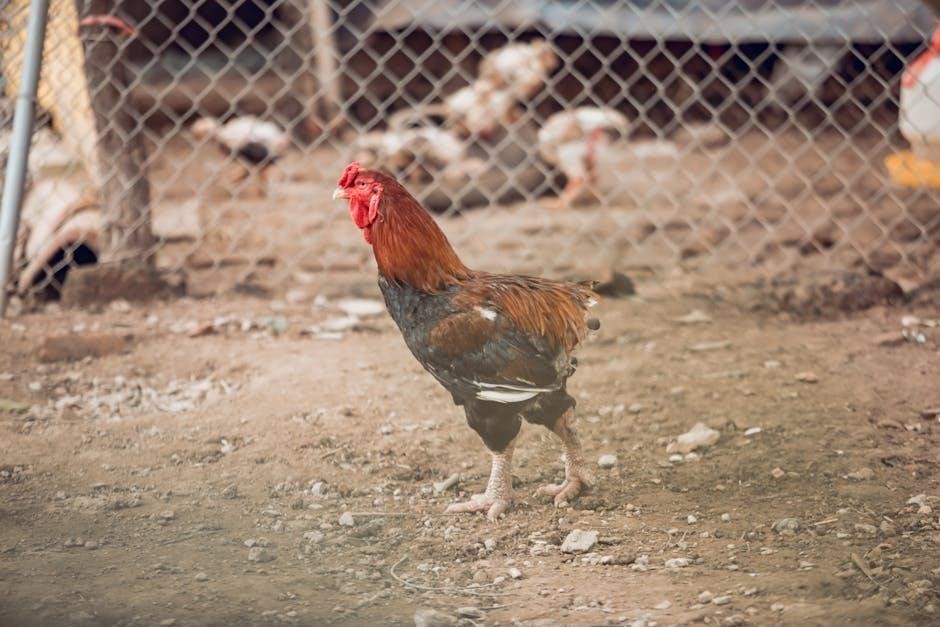VetRx for Chickens Instructions: A Comprehensive Guide
VetRx is a popular, all-natural poultry remedy used to support respiratory health and overall well-being in chickens. It is formulated from essential oils and herbs, to address common poultry ailments such as colds, roup, and other respiratory issues. It has been trusted for over 100 years.
What is VetRx Poultry Remedy?
VetRx Poultry Remedy is an all-natural formulation designed to aid in the treatment of respiratory problems in various types of poultry. This includes chickens, bantams, ducks, turkeys, geese, and game birds. It has been in use since 1874. Many people think of it as the Vicks Vaporub of the poultry medicine cabinet.
The remedy is a blend of essential oils and other natural ingredients known for their beneficial properties in supporting respiratory health. VetRx is used to alleviate symptoms associated with colds, roup, scaly legs, and even eye worms. Beyond treating ailments, it can also be used as a conditioner, particularly when preparing birds for shows.
VetRx is applied in several ways, including topically, orally, and through vaporizers. The versatility of its application methods makes it a convenient option for poultry keepers. The remedy provides a natural approach to managing common health issues in poultry.
Key Ingredients in VetRx
VetRx Poultry Remedy derives its effectiveness from a blend of natural ingredients carefully selected for their therapeutic properties. These components work synergistically to provide relief from various poultry ailments and support overall well-being.
Canada Balsam is one of the key ingredients. It is known for its soothing and anti-inflammatory properties. Camphor is another important component, acting as a decongestant and mild analgesic. This helps to relieve respiratory congestion and discomfort.
Oil of Origanum is included for its antimicrobial and antiseptic qualities, helping to combat infections. Oil of Rosemary is another essential oil in the formulation. It has stimulating and antiseptic effects. The specific formulation of these ingredients contributes to VetRx’s ability to address respiratory issues, scaly legs, and other common poultry problems. It makes it a trusted remedy for chicken keepers.
Conditions VetRx Can Help Treat

VetRx Poultry Remedy is a versatile treatment option for a range of conditions affecting chickens and other poultry. Primarily, it’s renowned for its effectiveness in addressing respiratory ailments. It provides relief from symptoms associated with colds and roup. These include sneezing, coughing, and nasal discharge.
Beyond respiratory issues, VetRx can also be used to manage scaly leg mites. These mites burrow under the scales of a chicken’s legs, causing discomfort and inflammation. VetRx helps to soothe the affected areas and combat the mites. It promotes healing.
Furthermore, VetRx can aid in the treatment of eye worms, a parasitic infection that can cause irritation and vision problems in chickens. In addition to treating specific ailments, VetRx can also be used as a general conditioner. This can enhance the overall health and appearance of poultry, particularly in preparation for shows.
Preparing VetRx Solution
Proper preparation of the VetRx solution is crucial for ensuring its effectiveness and the safety of your chickens. The general guideline involves diluting VetRx with warm water. The recommended ratio is one teaspoonful of VetRx to one cup of very warm water. It is important to use warm water, as VetRx mixes more readily with it.
It’s worth noting that VetRx tends to float on top of cold water. This characteristic can be useful for ensuring the solution is properly mixed before application. When warming VetRx, do so gently. Place the bottle in a small pan of water and heat it at medium temperature. Always test the temperature of the solution before use to avoid burning your birds.
Once the VetRx is adequately diluted, the solution is ready for administration using various methods. These can include topical application, oral administration, or vaporizer use, depending on the specific condition being treated and the size of the bird.
Dosage for Adult Chickens
Determining the correct dosage of VetRx for adult chickens is essential for achieving optimal results without causing harm. The standard dosage for adult chickens, including bantams and mature poultry of similar size, is generally consistent across various application methods. It is crucial to observe your chickens closely after administering VetRx to monitor their response and adjust the dosage if necessary.
For topical application, use one or two drops of warm, full-strength VetRx. For oral administration, a few drops of warm VetRx straight from the bottle can be given down the throat of the bird at night. When using a vaporizer, fill the cup with VetRx full strength and operate it for at least one hour while the birds are roosting.

When preparing a diluted solution, add one teaspoonful of warm VetRx to one cup of very warm water. This solution can be used for various applications, including adding a few drops to their drinking water every time you change it. Always use VetRx warm unless otherwise specified.
Dosage Adjustments for Different Bird Sizes
While standard dosages of VetRx are provided for adult chickens and bantams, it’s important to adjust these amounts based on the size of the bird to ensure safety and effectiveness. Larger birds, such as turkeys and geese, may require a higher dosage, while smaller birds, like chicks or very small bantams, will need a reduced amount.
The general principle is to adjust the dosage proportionally to the bird’s size. For larger birds, you might increase the amount of VetRx by 50% to 100%, carefully observing their reaction. For smaller birds, reduce the dosage to half or even a quarter of the standard amount.
When diluting VetRx in water, use the same proportional adjustments. If the standard is one teaspoon per cup of water, larger birds might benefit from 1.5 to 2 teaspoons per cup, while smaller birds should receive only 0.25 to 0.5 teaspoons per cup.
Always monitor birds closely after administering VetRx, especially when using adjusted dosages, to ensure they are responding well and not experiencing any adverse effects.
Methods of Application: Topical
Topical application of VetRx is a direct and effective method for addressing localized issues, such as scaly leg mites, dry skin, or minor respiratory symptoms. This method involves applying VetRx directly to the affected areas of the chicken’s body, allowing for targeted treatment and quick absorption.
For scaly leg mites, gently clean the chicken’s legs with warm, soapy water, then apply VetRx liberally to the affected scales, ensuring complete coverage. This helps to suffocate the mites and soothe the irritated skin. Repeat this process every few days until the mites are eradicated.
To address minor respiratory symptoms, rub a few drops of warm VetRx under the chicken’s wings. This allows the aromatic vapors to be inhaled as the bird preens and rests. Additionally, VetRx can be applied to the comb and wattles to soothe dry skin and enhance their natural color.
When applying VetRx topically, always use a clean cloth or cotton swab to prevent contamination. Ensure that the VetRx is warm to improve absorption and comfort for the bird.
Methods of Application: Oral
Administering VetRx orally is an effective way to deliver the remedy directly into the chicken’s system, aiding in the treatment of respiratory issues and promoting overall health. This method is particularly useful when dealing with more severe respiratory symptoms or when targeting internal ailments.
To administer VetRx orally, prepare a diluted solution by mixing one teaspoon of warm VetRx with one cup of very warm water. Ensure the water is warm, as VetRx tends to float on top of cold water. Using a dropper or syringe (without the needle), carefully administer a few drops of the warm VetRx solution directly into the chicken’s throat.
When administering, gently tilt the chicken’s head to the side and downwards to prevent choking. Watch for the VetRx to come from each side of the bird’s beak and corner of each eye. It is best to apply the solution in the evening or at night when the chickens are roosting.

Oral administration allows for rapid absorption and systemic distribution of the remedy, providing relief from respiratory congestion and supporting the bird’s immune system.
Methods of Application: Vaporizer Use
Using a vaporizer is an excellent method for delivering VetRx to an entire flock of chickens, especially when dealing with respiratory issues affecting multiple birds. This method disperses the remedy into the air, allowing the chickens to inhale the therapeutic vapors while roosting, providing relief and promoting respiratory health.
To utilize a vaporizer, it is crucial to use a hot water model. Fill the vaporizer cup with VetRx full strength, without dilution. Operate the vaporizer for at least one hour while the birds are roosting for the night. The heat from the vaporizer will cause the VetRx to evaporate, releasing its beneficial vapors into the air.
Ensure proper ventilation in the coop to prevent excessive humidity buildup. The aromatic vapors will penetrate the chickens’ respiratory systems, helping to clear congestion, soothe irritated airways, and support healthy upper respiratory function. This method is particularly effective for preventing colds and roup within the flock.
For optimal results, use the vaporizer in the evening or at night when the chickens are settled and roosting, allowing them to benefit from the VetRx vapors throughout the night.
Preventative Use of VetRx
VetRx isn’t just for treating sick chickens; it’s also a valuable tool for preventative care. Incorporating VetRx into your regular chicken care routine can help maintain respiratory health and prevent common ailments before they start.
To prevent colds and roup, sprinkle a few drops of VetRx directly into the coop litter every four to five days. This helps create an environment where the aromatic vapors continuously support the chickens’ respiratory systems. Additionally, add a few drops of VetRx to their drinking water each time you change it. This provides a subtle, ongoing dose of the remedy.

Another preventative measure is to rub one or two drops of warm, full-strength VetRx under the wings of your chickens. This allows them to inhale the vapors throughout the day and night, especially when they tuck their heads under their wings to rest;
VetRx can be a valuable tool for promoting overall respiratory health in your chickens, even when they aren’t showing signs of illness. Regular preventative use helps maintain a healthy flock and reduces the likelihood of respiratory problems.
VetRx for Scaly Leg Mites
Scaly leg mites are a common issue affecting chickens, causing discomfort and potential lameness if left untreated. VetRx can be a helpful aid in managing and alleviating scaly leg mites, offering a natural approach to soothing affected areas.
To treat scaly leg mites with VetRx, first, gently clean the chicken’s legs with warm, soapy water to remove any dirt or debris. Pat the legs dry and then apply VetRx liberally to the affected areas, ensuring you cover all scales thoroughly. The oil-based nature of VetRx helps to smother the mites and loosen their grip on the scales.
For best results, warm the VetRx slightly before application. Repeat this treatment every few days for several weeks, or until the scales begin to smooth and the mites are eradicated. Regular application is crucial to disrupting the mite’s life cycle. In addition to direct application, ensure the coop is clean and dry to prevent re-infestation.
VetRx’s soothing properties can help relieve the itching and irritation associated with scaly leg mites, promoting healing and restoring your chicken’s leg health. Always monitor your chickens closely and consult a vet if the condition persists or worsens.
VetRx for Eye Worms
Eye worms, while less common than other poultry ailments, can cause significant discomfort and vision problems in chickens. While VetRx is not a direct cure for eye worms, it can be used as a supportive treatment to alleviate irritation and promote healing while addressing the underlying issue.
If you suspect your chicken has eye worms, it’s crucial to consult with a veterinarian for proper diagnosis and treatment. Eye worms typically require specific medications to eliminate the parasites. However, VetRx can be used to gently cleanse the affected eye area and soothe inflammation.
To use VetRx for supportive care, dilute a small amount in warm water, creating a mild solution. Gently flush the affected eye with this solution using an eye dropper or a clean, soft cloth. This can help remove debris and reduce irritation. Be careful not to directly apply undiluted VetRx into the eye, as it may cause discomfort.
Additionally, applying a small amount of warm VetRx under the chicken’s wing can provide soothing vapors that may help with respiratory comfort, which can be beneficial if the eye worm infestation is causing any related symptoms. Always monitor your chicken closely and follow your veterinarian’s recommended treatment plan for eye worms.
Safety Precautions and Considerations
When using VetRx for your chickens, it’s essential to prioritize their safety and well-being by adhering to several key precautions. Always use VetRx warm, unless specifically directed otherwise. To warm the solution, place the bottle in a small pan of water and heat at medium temperature, and always test the temperature before use.
Avoid direct contact with the chicken’s eyes when using undiluted VetRx. If using as an eye wash, ensure the VetRx is properly diluted with warm water to prevent irritation. Never administer undiluted VetRx directly into the bird’s eye.
Monitor your chickens closely after applying VetRx. Watch for any signs of adverse reactions such as increased respiratory distress, lethargy, or skin irritation. If any of these symptoms occur, discontinue use and consult with a veterinarian.
VetRx is intended as a supportive remedy and not a replacement for veterinary care. If your chickens exhibit severe symptoms or their condition does not improve with VetRx, seek professional veterinary advice promptly. Follow dosage instructions carefully, adjusting for bird size as needed. Store VetRx in a cool, dry place, out of reach of children and animals.
